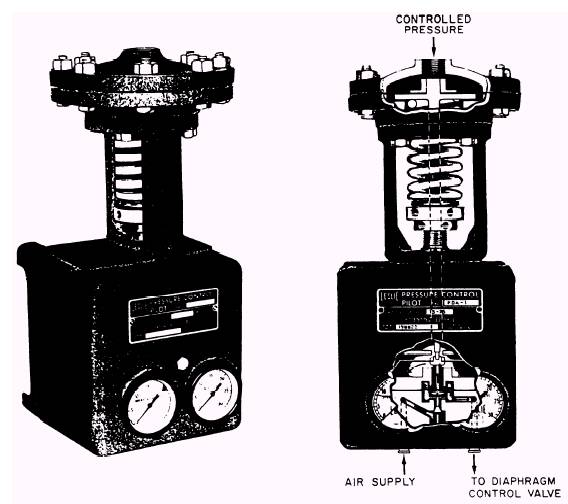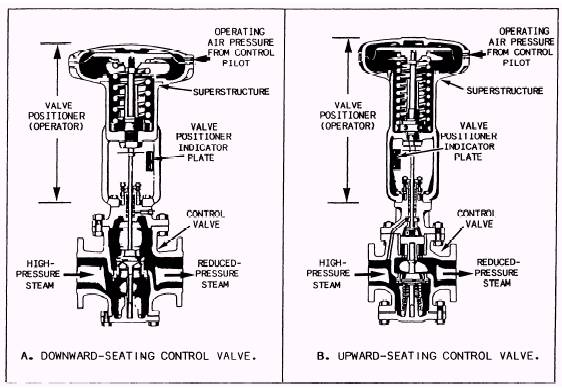|
Air-Pilot-Operated
Diaphragm Control Valves These
valves are used extensively on naval ships. The valves and their control pilots
are available in several designs to meet different requirements. They may be
used as unloading valves to reduce pressure or to provide continuous regulation
of pressure and temperature. They may also be used for the control of liquid
levels. The air-operated control pilot may be either direct acting or reverse
acting. A direct-acting pilot is shown in figure 13-30. In this type of pilot,
the controlled pressure-that is, the pres-sure from the discharge side of the
diaphragm control valve-acts on top of a diaphragm in the control pilot. This
pressure is balanced by the pressure exerted by the pilot adjust-ing spring.
When the controlled pressure in-creases and overcomes the pressure exerted by
the pilot adjusting spring, the pilot valve stem is forced downward. This action
opens the pilot valve to increase the amount of operating air pressure going
from the pilot
to
the diaphragm control valve. A reverse-acting pilot has a lever that reverses
the pilot action. In a reverse-acting pilot, therefore, an increase in
controlled pressure produces a decrease in operating air pressure. In the
diaphragm control valve, operating air from the pilot acts on a diaphragm
contained in the superstructure of the valve operator or posi-tioner. (See fig.
13-31.) It is direct-acting in some valves and reverse-acting in others. If the
valve operator is direct-acting, the operating air pressure from the control
pilot is applied to the TOP of the valve diaphragm. When the valve operator is
reverse-acting, the operating air pressure from the pilot is applied to the
UNDERSIDE of the valve diaphragm.
View
A in figure 13-31 shows a very simple type of direct-acting diaphragm control
valve. The operating air pressure from the control pilot is applied to the top
of the valve diaphragm. The valve in the figure is a downward-seating valve.
Therefore, any increase in operating air pressure

Figure 13-30.-Air-operated
control pilot.

Figure 13-31.-Diaphragm
control valves.
pushes
the valve stem downward. This tends to close the valve.
Now
look at view B. This is also a direct-acting valve. The operating air pressure
from the con-trol pilot is applied to the top of the valve diaphragm. But the
valve shown in view B is more complicated than the one shown in view A. The
valve shown in view B is an upward-seating valve rather than a downward-seating
valve. Therefore, any increase in operating air pressure from the control pilot
tends to OPEN this valve rather than to close it.
As we
have seen, the air-operated control pilot and the positioner of the diaphragm
control valve may be either direct-acting or reverse-acting. In addition, the
diaphragm control valve may be either upward-seating or downward-seating. These
factors, as well as the purpose of the installation, determine how the
diaphragm control valve and its air-operated control pilot are installed in
rela-tion to each other.
To
see how these factors are related, lets con-sider an installation; a diaphragm
control valve and its air-operated control pilot are used to supply reduced
steam pressure. Figure 13-32 shows one arrangement that we might use. We will
assume that the service requirements indicate the need for a direct-acting,
upward-seating, diaphragm control valve. Can you figure out which kind of a
control pilot-direct-acting or reverse-acting- should be used in this
installation?

Figure 13-32 .-Arrangement of control pilot and
diaphragm control valve for supplying reduced steam pressure.
Lets
try it first with a direct-acting control pilot. The controlled pressure
(discharge pressure from the diaphragm control valve) increases. When that
happens, increased pressure is applied to the diaphragm of the direct-acting
control pilot. The valve stem is pushed downward and the valve in the control
pilot is opened. This sends an in-creased amount of operating air pressure from
the control pilot to the top of the diaphragm control valve. The increased
operating air pressure acting on the diaphragm of the valve pushes the stem
downward. Since this is an upward-seating valve, this action OPENS the
diaphragm control valve still wider. Obviously, this wont work-for this
application, an INCREASE in controlled pressure must result in a DECREASE in
operating air pressure. Therefore, we made a mistake in choos-ing the
direct-acting control pilot. For this particular pressure-reducing application,
we should choose a REVERSE-ACTING control pilot.
You
will probably not need to decide which type of control pilot and diaphragm
control valve are needed in any particular installation. But you must know how
and why they are selected so that you will not make mistakes in repairing or
replac-ing these units.
|

